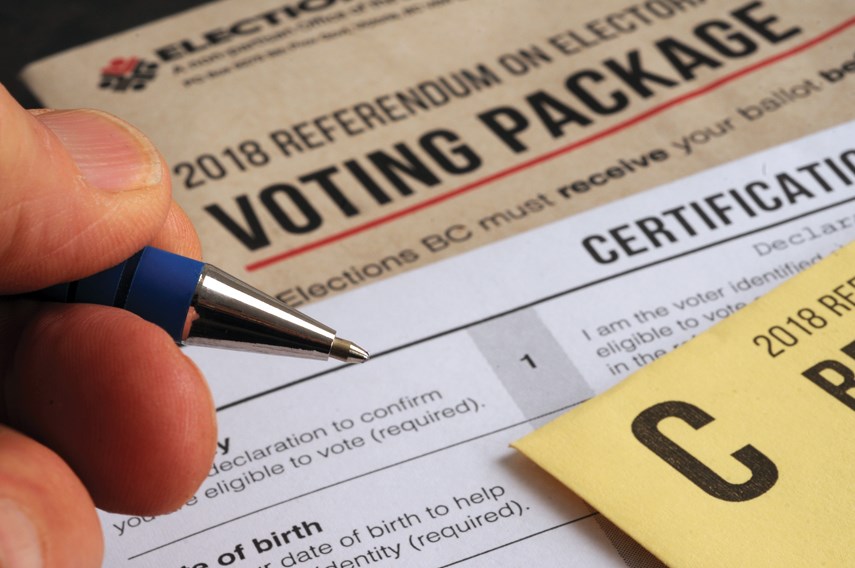UPDATE: Elections BC has now extended the deadline for receiving ballots to 4:30 p.m. on Dec. 7. The decision was made in light of rotating strikes by Canada Post. The deadline to request a voting package is still midnight Nov. 23.
With one week to go until the deadline for Elections BC to receive completed ballots on the electoral reform referendum, between 15 and 20 per cent of voters on the North Shore have returned their ballots.
The mail-in referendum is being held to determine whether B.C. should keep the current first-past-the-post system of forming government or switch to a form of proportional representation.
The deadline by which Elections BC must receive completed ballots is Nov. 30.
So far, the percentage of ballots that have been returned by North Shore voters varies by riding from a low of 14.2 in West Vancouver-Sea to Sky to a high of 20.3 per cent in West Vancouver-Capilano.
Voters in North Vancouver-Lonsdale had returned 15.7 per cent of their ballots, while the number returned in North Vancouver-Seymour was 18.3 per cent.
Provincewide, numbers also range widely – from six or seven per cent returned in some Surrey ridings to 25 per cent in Parksville-Qualicum.
“I’m a little surprised at how slowly it’s unfolding,” said Patrick Smith, a political science professor at Simon Fraser University. Currently polls indicate the two sides of the argument are in a dead heat. That could easily mean a push to get in last-minute ballots, said Smith.
“I would say we are seeing greater returns generally now,” said Rebecca Penz, spokeswoman for Elections BC. Some of that variation is likely due to rotating strikes by Canada Post that have had an impact on the mail-in ballots, she added.
Registered voters should have received a voting package in the mail between Oct. 22 and Nov. 2. Anyone who did not receive a package has until today (Nov. 23) to request one. Voters can visit Elections BC at elections.bc.ca/ovr or call 1-800-661-8683 to request a voting package. Packages are also available at the North Vancouver referendum office at 120 Lonsdale Ave. That office is open 8:30 a.m. to 4:30 p.m., Monday to Friday.
As of Thursday, Elections BC had not decided whether the Canada Post strikes warranted an extension of the deadline to return the referendum ballots.
Penz said voters should get their ballots in the mail as soon as possible.
Voters can also drop off completed ballots at the referendum office at 120 Lonsdale Ave. by the close of business on Nov. 30 and the ballot will be considered received by Elections BC.
This fall’s referendum is the third time the province has voted on whether to change the voting system. In 2005, citizens voted 57.7 per cent in favour of switching to proportional representation – just under the 60 per cent threshold.
For this vote, the threshold has been set at 50 per cent plus one.
Although arguments have been heated on both sides of the debate, political scientists have said there are pros and cons to both first past the post and proportional representation systems.
First past the post usually creates majority governments with clear mandates and accountability. Proportional representation more often leads to coalition governments where parties are forced to compromise and work together.
There are “different visions of democracy” behind those who support first past the post and those who support a proportional representation system, said UBC political science Prof. Maxwell Cameron.
Statistics of the last seven provincial elections show that in the four North Shore ridings, 56 per cent of all the votes cast went to the BC Liberals, 26 per cent to the BC NDP and 11 per cent to the Greens, and yet, of the 28 races, the Liberals won 26 and BC NDP won two.
This is the third time voters in B.C. have cast ballots on electoral reform. Voters came closest to changing voting systems in 2005, when 57.7 of them cast ballots in favour of a form of proportional representation, just short of the threshold.
– with files from
Maria Rantanen



